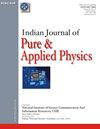电气用fe3o4 -油酸酯/聚乙烯醇纳米复合材料的合成与表征
IF 1.1
4区 物理与天体物理
Q4 PHYSICS, MULTIDISCIPLINARY
引用次数: 0
摘要
本文报道了将Fe-OA纳米颗粒(NPs)掺入聚乙烯醇(PVA)中,采用溶液浇铸法制备了一系列高柔韧性的Fe-OA-PVA纳米复合材料。纳米复合材料以不同的重量百分比(0.25 wt. %, 0.5wt. %)制备。%, 0.75wt。wt %, 1。%和2wt。%)的Fe3O4-OA加入到PVA矩阵中。采用FTIR、UV-Vis、XRD、接触角、阻抗谱、SEM和EDS对合成的纳米复合材料进行了表征。紫外可见光谱通过在223nm、325nm和410nm处观察峰初步证实了Fe-OA NPs与PVA基体的相互作用。FTIR研究发现了NPs和PVA聚合物基体之间相互作用的证据。将NPs掺入聚合物基体中,由于其性质,显示出各种性能的增强。采用接触角技术研究了复合材料的表面性能。采用阻抗谱法对油酸fe3o4 /PVA纳米复合膜的电性能进行了表征。由于fe3o4 -油酸NPs分散到PVA基体中,我们获得了偶极子的极化,从而获得了良好的交流导电性。这些合成的纳米复合材料有可能用于电子领域。本文章由计算机程序翻译,如有差异,请以英文原文为准。
Synthesis and Characterization of Fe3O4-oleate/Poly (vinyl alcohol) Nanocomposites for Electrical Applications
Herein we report the Fe3O4-oleate (Fe-OA) nanoparticles (NPs) incorporated poly (vinyl alcohol) (PVA), a series of highly flexible nanocomposites (Fe-OA-PVA) were prepared by the solution casting technique. The nanocomposites were fabricated with different weights per cent (0.25 wt. %, 0.5wt. %, and 0.75wt. %, 1wt. %, and 2wt. %, respectively) of Fe3O4-OA into the PVA matrix. The synthesized nanocomposites were characterized using FTIR, UV–Vis, XRD, Contact angle, Impedance spectroscopy, SEM and EDS. UV-Vis spectra initially confirmed the interaction of Fe-OA NPs into the PVA matrix by observing peaks at 223nm, 325nm and 410nm. The FTIR investigation uncovered evidence of an interaction between the NPs and the PVA polymer matrix. The incorporation of NPs into a polymer matrix shows an enhancement in various properties due to its nature. The surface properties of the composites were studied using the contact angle technique. The electric properties of Fe3O4-oleate/PVA nanocomposite films were estimated using impedance spectroscopy. Due to the dispersion of Fe3O4-oleate NPs into the PVA matrix, we obtained the polarization in dipoles, resulting in good AC-Conductivity properties. These synthesized nanocomposites may potentially use for electronic applications.
求助全文
通过发布文献求助,成功后即可免费获取论文全文。
去求助
来源期刊
CiteScore
1.30
自引率
14.30%
发文量
42
审稿时长
7 months
期刊介绍:
Started in 1963, this journal publishes Original Research Contribution as full papers, notes and reviews on classical and quantum physics, relativity and gravitation; statistical physics and thermodynamics; specific instrumentation and techniques of general use in physics, elementary particles and fields, nuclear physics, atomic and molecular physics, fundamental area of phenomenology, optics, acoustics and fluid dynamics, plasmas and electric discharges, condensed matter-structural, mechanical and thermal properties, electronic, structure, electrical, magnetic and optical properties, cross-disciplinary physics and related areas of science and technology, geophysics, astrophysics and astronomy. It also includes latest findings in the subject under News Scan.

 求助内容:
求助内容: 应助结果提醒方式:
应助结果提醒方式:


